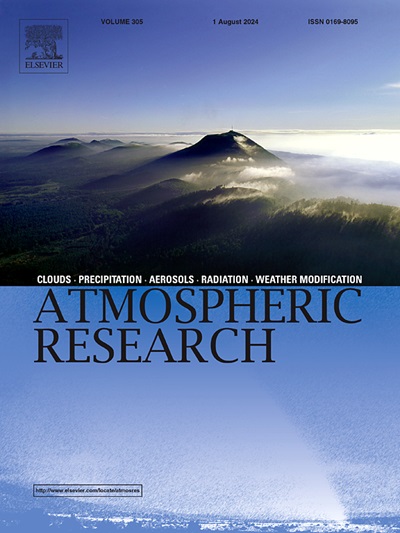Type-based assessment of aerosol direct radiative effects: A proof-of-concept using GEOS-Chem and CATCH
IF 4.5
2区 地球科学
Q1 METEOROLOGY & ATMOSPHERIC SCIENCES
引用次数: 0
Abstract
The radiative perturbation of the Earth's energy balance caused by all aerosols, the direct radiative effect (DRE), and anthropogenic aerosols, the direct radiative forcing (DRF), remain major sources of uncertainty in climate projections. Here we propose a method for determining DRE and DRF that makes use of the High Spectral Resolution Lidar (HSRL)-retrieved aerosol loading and derived aerosol types (i.e. dust, marine, urban, smoke, etc.) in combination with aerosol-type specific optical properties. As the global spatiotemporal distributions of HSRL-derived aerosol types are not currently available, the methodology is tested here using a global 3-D model of atmospheric chemistry (GEOS-Chem) along with Creating Aerosols from CHemistry (CATCH) algorithm-generated aerosol types analogous to ones derived by HSRL. In this method, the Rapid Radiative Transfer Model for General Circulation Models (RRTMG) is used to perform radiative transfer calculations with the single scattering albedo (SSA) and asymmetry parameter (g) of atmospheric particles assigned based on the aerosol type in each grid box. Average GEOS-Chem/CATCH-derived all-sky DRE and DRF across the North American domain are estimated to be −1.98 W/m2 and − 0.77 W/m2, respectively between mid-January and early February 2013 and − 4.20 W/m2 and − 1.41 W/m2 respectively between mid-July and early August 2014. Sensitivity studies revealed that the scheme may produce up to about ±0.42 W/m2 and ± 0.21 W/m2 uncertainty in DRE and DRF, respectively, related to variability in aerosol type-specific optical properties. This study presents a new way of determining DRE and DRF estimates once global retrievals of aerosol intensive parameters by HSRL become available.
基于类型的气溶胶直接辐射效应评估:使用GEOS-Chem和CATCH的概念验证
所有气溶胶造成的地球能量平衡的辐射扰动,即直接辐射效应(DRE)和人为气溶胶,即直接辐射强迫(DRF),仍然是气候预估中不确定性的主要来源。在这里,我们提出了一种确定DRE和DRF的方法,该方法利用高光谱分辨率激光雷达(HSRL)检索的气溶胶载荷和衍生的气溶胶类型(即灰尘、海洋、城市、烟雾等),结合气溶胶类型的特定光学特性。由于目前还无法获得HSRL衍生气溶胶类型的全球时空分布,因此本文使用全球三维大气化学模型(GEOS-Chem)以及化学生成气溶胶(CATCH)算法生成的类似于HSRL衍生气溶胶类型的气溶胶类型来测试该方法。该方法采用快速辐射传输模式(RRTMG),在每个网格框中根据气溶胶类型分配大气粒子的单散射反照率(SSA)和不对称参数(g),进行辐射传输计算。据估计,2013年1月中旬至2月初,北美地区的平均GEOS-Chem/ catch全天候DRE和DRF分别为- 1.98 W/m2和- 0.77 W/m2, 2014年7月中旬至8月上旬分别为- 4.20 W/m2和- 1.41 W/m2。灵敏度研究表明,该方案可能产生高达±0.42 W/m2和±0.21 W/m2的不确定度,分别与气溶胶类型特定光学性质的变化有关。这项研究提供了一种新的方法来确定DRE和DRF的估计,一旦全球气溶胶强度参数的HSRL检索是可用的。
本文章由计算机程序翻译,如有差异,请以英文原文为准。
求助全文
约1分钟内获得全文
求助全文
来源期刊

Atmospheric Research
地学-气象与大气科学
CiteScore
9.40
自引率
10.90%
发文量
460
审稿时长
47 days
期刊介绍:
The journal publishes scientific papers (research papers, review articles, letters and notes) dealing with the part of the atmosphere where meteorological events occur. Attention is given to all processes extending from the earth surface to the tropopause, but special emphasis continues to be devoted to the physics of clouds, mesoscale meteorology and air pollution, i.e. atmospheric aerosols; microphysical processes; cloud dynamics and thermodynamics; numerical simulation, climatology, climate change and weather modification.
 求助内容:
求助内容: 应助结果提醒方式:
应助结果提醒方式:


